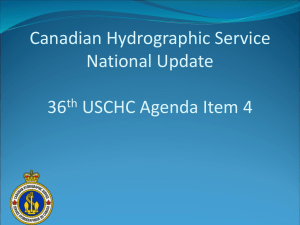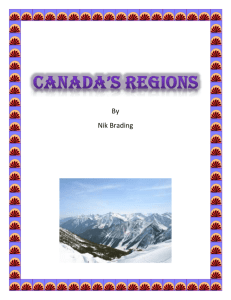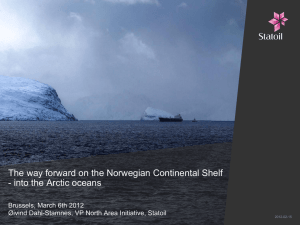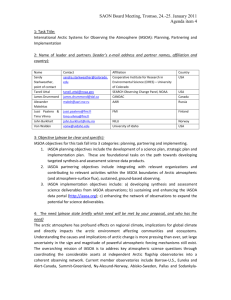Your ref
advertisement
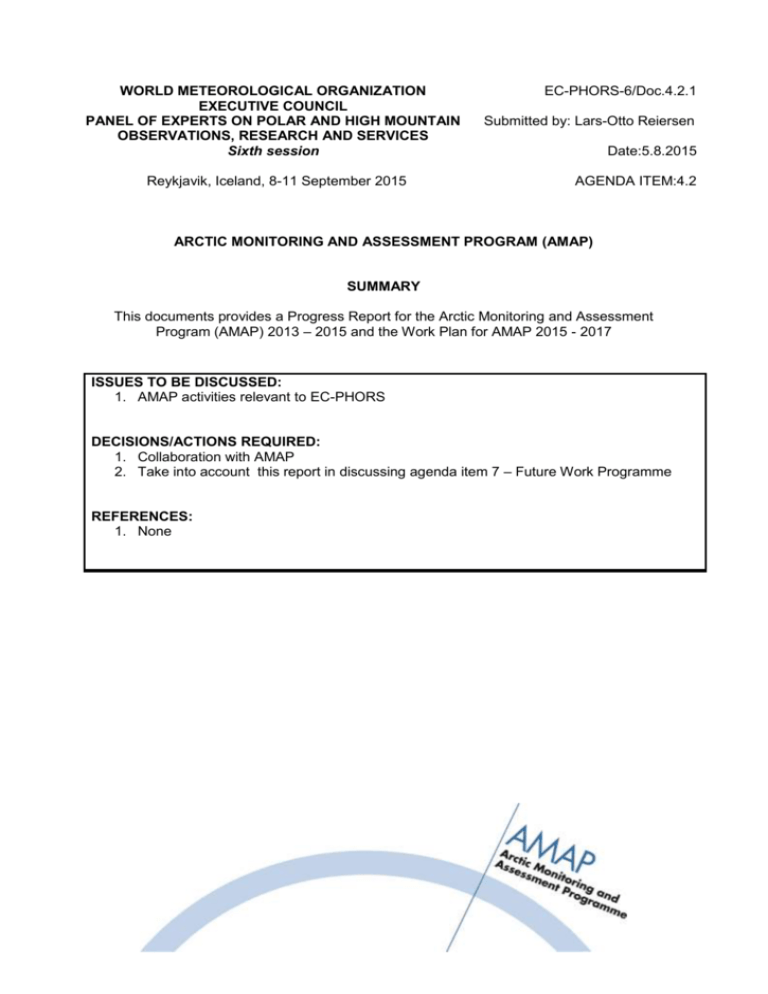
WORLD METEOROLOGICAL ORGANIZATION EXECUTIVE COUNCIL PANEL OF EXPERTS ON POLAR AND HIGH MOUNTAIN OBSERVATIONS, RESEARCH AND SERVICES Sixth session Reykjavik, Iceland, 8-11 September 2015 EC-PHORS-6/Doc.4.2.1 Submitted by: Lars-Otto Reiersen Date:5.8.2015 AGENDA ITEM:4.2 ARCTIC MONITORING AND ASSESSMENT PROGRAM (AMAP) SUMMARY This documents provides a Progress Report for the Arctic Monitoring and Assessment Program (AMAP) 2013 – 2015 and the Work Plan for AMAP 2015 - 2017 ISSUES TO BE DISCUSSED: 1. AMAP activities relevant to EC-PHORS DECISIONS/ACTIONS REQUIRED: 1. Collaboration with AMAP 2. Take into account this report in discussing agenda item 7 – Future Work Programme REFERENCES: 1. None EC-PHORS-6/Doc.4.2.1, p. 2 PROGRESS REPORT FOR ARCTIC MONITORING AND ASSESSMENT PROGRAM (AMAP) 2013 – 2015 & WORK PLAN FOR AMAP 2015 - 2017 I. Progress Report for AMAP 2013 – 2015 MANDATE To monitor and assess the status of the Arctic region with respect to pollution and climate change by documenting the levels and trends, pathways and processes, and effects on ecosystems and humans, and to propose actions to reduce associated threats for consideration by governments. AMAP produces sound, science-based, policy-relevant assessments and public outreach products to inform policy and decision-making processes. SUMMARY As health is an important aspect of society, the AMAP Human Health Assessment Group has prepared an updated assessment of the dietary exposure of Arctic populations to environmental contaminants, their health effects, and various means to communicate such risks to exposed groups. AMAP expert groups have prepared scientific assessments of the short-lived climate pollutants black carbon and tropospheric ozone and also of methane in the Arctic. The AMAP WG has prepared a summary report for policy-makers based on these two scientific assessments. The work under the AMAP expert groups on Short-Lived Climate Pollutants (SLCPs) has been conducted in parallel with the Arctic Council Task Force on Black Carbon and Methane (TFBCM). Work to follow-up AMAP’s assessment of Snow, Water, Ice and Permafrost in the Arctic (SWIPA) has been initiated with regard to a freshwater budget for the Arctic and Arctic carbon cycling, and also to update the SWIPA assessment concerning the status of sea and land ice, glaciers and ice caps, snow and permafrost, and trends and feedbacks. These activities support AMAP’s work under the project Adaptation Actions for a Changing Arctic (AACA). In relation to environmental contaminants, AMAP expert groups have prepared updated scientific assessments of radioactivity and of trends in persistent organic contaminants in the Arctic. The policy-relevant conclusions and recommendations from these two assessments, together with those from the updated assessment of human health in the Arctic, are being compiled in the report Arctic Pollution 2015 –Summary for Policy-makers. Follow-up work on AMAP’s Arctic Ocean Acidification assessment (2013) has also been initiated. Under the project Adaptation Actions for a Changing Arctic, Regional Integration Teams covering the three pilot areas, 1) the Barents region, 2) Baffin Bay/Davis Strait, and 3) the Bering/Chukchi/Beaufort region, have worked in cooperation with regional communities and other stakeholders to develop detailed plans for their work and assessment reports. Sustaining Arctic Observing Networks (SAON) work has been enhanced with the establishment of two committees to consider data/information services and observations and networks covering the full range of Arctic social, economic, health and environmental sciences data and observations. AMAP has worked closely with other entities of the Arctic Council on cross-cutting issues, and has engaged with international organisations and conventions. Results of Arctic Council EC-PHORS-6/Doc.4.2.1, p. 3 work performed under the auspices of AMAP have been presented at scientific conferences and at public outreach events. DELIVERABLES/ACHIEVEMENTS Sustainable Circumpolar Communities The updated AMAP human health assessment report contributes to this priority by addressing health aspects in relation to environmental contaminants in local traditional foods. This report acknowledges the nutritional and cultural values of traditional foods, but notes that certain food species in some Arctic areas contain concentrations of contaminants, particularly mercury, that can cause health effects in vulnerable groups, especially developing foetuses, infants and young children. Dietary advice can help indigenous communities to avoid contaminant exposure, but is complex and is not a long-term solution. This report also provides initial thoughts on adaptation issues for small Arctic communities to the combined impact of climate change, environmental contaminants and emerging increased risks of animal-borne infectious diseases. Adaptation Actions for a Changing Arctic (AACA) Activity on AACA included the establishment of the AACA Integration Team and Regional Integration Teams for the three pilot areas chosen for the project: 1) Barents; 2) Davis Strait/Baffin Bay; and 3) Bering/Chukchi/Beaufort. These regional teams work in close consultation with stakeholders to produce information to assist local decision-makers and stakeholders to develop adaptation tools and strategies to deal with climate change and other environmental stressors. The three regions have prepared detailed assessment outlines and identified lead authors. The AACA Integration Team has provided overall coordination of this work, which has included workshops on climate scenarios and modelling and the preparation of a report on socio-economic drivers of change in the Arctic. AMAP is coordinating with other Arctic Council Working Groups and international science organizations in this work. A progress report on activities under the AACA project is provided. Assessment of Short-Lived Climate Pollutants in the Arctic Two AMAP expert groups have completed assessments of the emission sources, transport of black carbon and tropospheric ozone and methane to the Arctic and their effects on Arctic climate. Based on the results of these assessments, AMAP has prepared a policy-makers summary, the Arctic Climate Issues report, including key findings and conclusions of the two assessments, as a deliverable to the 2015 Ministerial Meeting. The work under the AMAP SCLP expert groups has been conducted in parallel with and provided technical input to the Arctic Council TFBCM. Updated assessment of human health in the Arctic The AMAP human health assessment group has prepared an updated assessment covering the results of biomonitoring of concentrations of environmental contaminants in human residents of the Arctic, evaluation of the potential and observed effects of these contaminants, and risk assessment and risk communication issues for Arctic communities. This report also includes information on recent actions to assist small Arctic communities to adapt to the combined impacts of climate change, environmental contaminants, and emerging risks of infectious animal-borne diseases. A summary of the policy-relevant outcome of this assessment, containing conclusions and recommendations, has been included in the Arctic Pollution 2015 report. EC-PHORS-6/Doc.4.2.1, p. 4 Updated assessment of trends of POPs in the Arctic: AMAP has prepared an updated assessment of the temporal trends of persistent organic pollutants (POPs) in air and biota as well as in humans in the Arctic based on long-term monitoring data. This report has been provided to the UNEP Secretariat responsible for conducting an ongoing Stockholm Convention effectiveness evaluation review, in accordance with Arctic Council instructions that support AMAP implementation of the work under this Convention. A summary of the policy-relevant outcome of this assessment, containing conclusions and recommendations, has been included in the Arctic Pollution 2015 report. Work continues on additional components of an updated POPs assessment that includes new contaminants of emerging concern in the Arctic and biological effects. Updated assessment of radioactivity in the Arctic This updated assessment includes new information on decommissioning and handling of radioactive waste; accidental releases of radioactivity, including assessment of the consequences for the Arctic of the Fukushima accident; and technologically enhanced releases of naturally occurring radionuclides (TENORM) from mining and oil and gas activities. A summary of the policy-relevant outcome of this assessment, containing conclusions and recommendations, has been included in the Arctic Pollution 2015 report. Unmanned Aircraft Systems (UAS) The AMAP expert group on UAS has prepared an updated white paper on access in the Arctic for unmanned aircraft systems for scientific research, monitoring and search and rescue purposes. It has also prepared a manual of operating guidelines for the use of such vehicles. These documents should be ready for release later in 2015. Sustaining Arctic Observing Networks (SAON) SAON has further developed its work by the establishment of two committees: the Committee on Data and Information Services will prepare overall strategies to improve access to data and information in northern areas, and the integration and dissemination of data and information through a SAON-led Circum-Arctic Information System. The Committee on Observations and Networks will prepare overall strategies to improve the collection of data and information from observations relating to Arctic social, economic, health and environmental sciences, including options for long-term funding of operations and the establishment of a set of early-warning indicators of change in the Arctic. Arctic Ocean Acidification Following the delivery of the Arctic Ocean Acidification (AOA) assessment and its related policy-makers summary report in 2013, AMAP has begun a follow-up activity based on the recommendations in the assessment report. Technical support for UNEP AMAP provided technical input to the ongoing Stockholm Convention effectiveness review process and continues to communicate relevant results of AMAP work on new chemicals to the groups under the Stockholm Convention and LRTAP Convention responsible for reviewing chemicals proposed for listing under these agreements. AMAP contributed to the work to secure the agreement of the Minamata Convention on mercury, including the work to prepare the UNEP Global Mercury Assessment (GMA) 2013. These activities ensure that Arctic information is well represented in the work of the Conventions. EC-PHORS-6/Doc.4.2.1, p. 5 Translation of reports The overview report on SWIPA and the Arctic Ocean Acidification Overview report as well as the AACA information brochure have been translated into both Russian and Saami and will be published soon. II. Work Plan for AMAP 2015 - 2017 SUMMARY The AMAP work plan 2015-2017 continues the work to monitor and assess the status of the Arctic region with respect to pollution and climate change by documenting the levels and trends, pathways and processes, and effects on ecosystems and humans, and to propose actions to reduce associated threats for consideration by governments. Regional assessments will be produced under the Adaptation Actions for a Changing Arctic (AACA) process for three regions: Barents, Baffin Bay/Davis Strait, and Bering/Chukchi/Beaufort regions, together with an overall integrated AACA report. AACA will provide information to assist regional and local decision-makers and stakeholders to develop adaptation tools and strategies to deal with climate change and other environmental stressors. Assessments of the freshwater budget and the carbon cycle of the Arctic are under preparation, as well as updated assessments of Arctic land ice, permafrost, glaciers and ice caps, and feedbacks and trends in the cryosphere. Further work on Arctic Ocean acidification will continue, with more focus on case studies in specific areas. An assessment of contaminants of emerging concern in the Arctic ecosystem will be prepared. Guidelines regarding the use of unmanned aircraft systems for scientific monitoring and research in the Arctic will be finalized. Work will continue under the Sustaining Arctic Observing Networks (SAON) program, and AMAP will continue to provide input to the work of other international organizations. DELIVERABLES/ACHIEVEMENTS Adaptation Actions for a Changing Arctic (AACA) This initiative is supported by several regional teams. The Barents regional implementation includes Norway, Russia, Sweden and Finland. The Baffin Bay/Davis Strait regional implementation includes Denmark/Greenland and Canada; the Bering/Chukchi/Beaufort regional implementation includes the U.S., Russia and Canada. Work will continue on Arctic‐focused climate and integrated environmental frameworks and models that can improve projections of climate change and other relevant drivers of Arctic change in order to improve predictions and inform the development and implementation of adaptation actions by Arctic States and Permanent Participants. This project aims to clarify the basis for adaptation strategies to meet user needs and analyse consequences that may occur in relation to combined effects on ecosystems and socio‐economic development. Information for relevant sectors will be compiled and evaluated, and integrated regional reports and other products will be prepared to improve predictive capability of the consequences of climate change and other relevant drivers of change. AMAP is leading the work, which is being developed in collaboration with other relevant Arctic Council working groups and international science organizations. A progress report will be presented in 2015, other products are anticipated during 2015–2017, and final integrated reports will be produced in 2017. EC-PHORS-6/Doc.4.2.1, p. 6 Food and Water Security, including Arctic Freshwater Synthesis component of Snow, Water, Ice and Permafrost (SWIPA) update Information relevant to this subject will be provided by AMAP assessment groups including the Human Health Assessment Group and the AMAP/International Arctic Science Committee (IASC)/WRCP CliC (World Climate Research Programme’s Climate and the Cryosphere project) joint project on Arctic Freshwater Synthesis. This latter assessment is one component of the update of the 2011 AMAP SWIPA assessment. This component will prepare the first overall budget of freshwater resources in the Arctic and a synthesis of the current status. Planned work includes the preparation of an overall budget for the freshwater resources of the Arctic and projections on the influence of climate change on hydrological conditions (lead: Canada). Update of Snow, Water, Ice and Permafrost (SWIPA) assessment This assessment will update parts of the 2011 AMAP SWIPA Assessment, using updated climate change scenarios and more refined models, as well as more recent information on current and projected changes in the cryosphere of the Arctic. Relevant information from this work will be provided to the AACA project. Planned work and deliverables include updated information on trends and projections of climate-induced changes in Arctic snow, ice and hydrological conditions. This initiative has a number of leads, including Canada, Norway, U.S. on sea ice; Norway, Russia, and U.S. on permafrost; Russia and U.S. on Arctic trends and feedbacks; Canada on snow; Denmark/Greenland on the carbon cycle, Denmark/Greenland, Russia and Canada on land ice and Canada on the Arctic freshwater synthesis. Scientific evaluation of Short-Lived Climate Pollutants (SLCPs) in the Arctic AMAP will continue to address short-lived climate pollutants (black carbon, ozone and methane) and their impacts on Arctic climate to implement follow-up actions arising from assessments delivered by the AMAP methane and black carbon/ozone expert groups and the Arctic Council Task Force on Black Carbon and Methane in line with decisions of the Arctic Council at their meeting in 2015. This work will address, among other topics, improved monitoring, modelling and assessment of trends and effects of short-lived climate pollutants in the Arctic (leads: Canada, Norway, U.S.). Climate Change Indicator System for the Arctic This activity will build on the set of climate change indicators currently under development by the United Stated Global Climate Change Research Program (USGCRP) to indicate the status and trends of change in key physical, biological, social and economic parameters related to climate impacts and effects. This activity will involve all Arctic states and Permanent Participants to link a subset of indicators focussed on climate change into a single pan-Arctic network, the Climate Change Indicator System for the Arctic (CCISA). Planned work includes contributing to the development of the framework for the CCISA and illustrating the potential for an Arctic Indicators Network by identifying a subset of Arcticrelevant indicators from the larger USGCRP effort (lead: U.S.). Updated assessment of Arctic Ocean Acidification This assessment will update the 2013 AMAP Arctic Ocean Acidification Assessment, including new information on the extent and effects of acidification in the Arctic Ocean, particularly in relation to biological effects, and will contain case studies of the impacts of ocean acidification in several specific Arctic areas. Planned work and deliverables include an EC-PHORS-6/Doc.4.2.1, p. 7 updated assessment of Arctic Ocean acidification, to be delivered in 2017 (leads: Norway, U.S.). AMAP Trends and Effects Monitoring Programme: Implementation 2015-2017 and related Arctic monitoring and research activities AMAP will continue to implement monitoring and assessment in accordance with the approved AMAP Strategic Framework for 2010+. AMAP will update its monitoring guidelines and protocols as part of an ongoing process, in particular to address areas relating to monitoring of cryosphere change, ocean acidification and other impacts of climate change. As part of its on‐going work, AMAP will continue to coordinate work, based largely on national programs, to provide the information necessary for assessment of relevant issues such as: spatial and temporal trends in levels of contaminants in Arctic ecosystems, including humans, and radioactivity in Arctic ecosystems; biological/ecological effects of contaminants and associated trends, including human health effects; climate change, including ocean acidification, SLCFs and cryosphere; effects of climate variability and change; improved predictive capacity through increased observations, research and understanding of processes governing changes in the Arctic; human and ecosystem health effects; and combined effects of contaminants, climate change and other stressors, including effects on humans. AMAP will continue to coordinate and deal with new activities to ensure appropriate data reporting and archiving, including reporting of data to AMAP Thematic Data Centres. AMAP will cooperate with international partners and arrange workshops to improve monitoring capability, including the use of remote sensing. AMAP will also continue its work on coordination of Arctic monitoring and research through engagement in relevant initiatives under the EU’s Horizon 2020 Programme (including EUPolarNet) and the Third International Conference on Arctic Research Planning (ICARP III). AMAP’s Climate Expert Group and the Human Health Assessment Group will participate in the further development and implementation of special projects in Russia, including the project on the Lena and other Russian Arctic rivers under the GEF‐Russian Federation Partnership, implementation of air monitoring, and follow‐up on the Persistent Toxic Substances project. Updated assessment of pollution issues As part of its ongoing work, AMAP will continue to evaluate emerging issues of concern related to pollution and climate change and their effects on Arctic ecosystems and populations. Plans for follow-up activities and products in relation to this as well as previously identified issues of concern will be developed as necessary. This work will prepare an updated assessment of POPs, including chemicals of emerging Arctic concern, biological effects, and the influence of climate change on POPs, for delivery in 2017 (leads: Canada and Sweden). EC-PHORS-6/Doc.4.2.1, p. 8 Use of Unmanned Aircraft Systems (UAS) for scientific purposes in the Arctic AMAP will continue to develop and finalize safety guidelines and demonstrate the use of UAS in cross-jurisdictional environmental monitoring and other studies. This work will develop guidelines and proposals for the use of UAS in the Arctic for scientific and other appropriate activities. Guidelines and proposals for UAS use in the Arctic will be finalized (leads: Norway, U.S.). Sustaining Arctic Observing Networks (SAON) AMAP will contribute to the implementation of the SAON and continue to co‐lead its development on behalf of the Arctic Council, together with the International Arctic Science Committee (IASC) with the aim of supporting and developing Arctic observing networks. The AMAP Secretariat, together with the IASC Secretariat, will continue to provide secretariat support. Support for international activities AMAP has been requested by the Arctic Council to support relevant activities under international bodies such as the UNEP (Stockholm Convention on POPs, Minamata Convention on mercury, UNFCCC) and UN ECE (LRTAP Convention) with regard to provision of Arctic information to relevant groups and supporting the development and implementation of global monitoring and other activities to ensure harmonization with the AMAP Trends and Effects Programme. The main activities include coordination and information exchange activities in relation to the United Nations Environment Programme (UNEP) Chemicals Branch (DTIE), Stockholm Convention and UN ECE Convention on LongRange Trans-boundary Air Pollution, UNFCCC IPCC and the SWIPA assessment results, the EU-PolarNet and Trans-Atlantic Ocean Research Alliance and the Combined Effects of Contaminants and Climate Change. Communication and Outreach AMAP will implement communication and outreach activities in accordance with the AMAP Communications and Outreach Plan and the Arctic Council’s Communications and Outreach Guidelines in the dissemination of AMAP results to relevant stakeholders. Activities will focus on delivery and dissemination of information arising from AMAP assessments and relatedwork addressing, inter alia: AACA, AOA, SWIPA, OGA, mercury, radioactivity, SLCFs, POPs, human health and SAON. AMAP communication and outreach will be accomplished through the production and dissemination of reports (including, where possible, their translation), films, fact sheets, website, educational materials and other outreach products. AMAP will continue to contribute relevant AMAP‐related scientific input to the Arctic Report Card Arctic Resilience Report With the accelerating pace of environmental, social and economic changes in the Arctic and the abruptness and irreversibility of many of these changes, the sustainability of Arctic ecosystems and communities is increasingly challenged. Resilience - the capacity to effectively respond to change in social-ecological systems - is becoming ever more important for the Arctic communities. Insights from the Arctic Resilience Report (ARR) work will help people living in the Arctic to strengthen their capacity for navigating change under conditions in which rapid and unexpected developments are likely. EC-PHORS-6/Doc.4.2.1, p. 9 MANDATE An initiative of the Swedish Arctic Council Chairmanship , the mandate for the ARR was set out by the Arctic Council at its meeting in November 2011. The SAO report to the Nuuk Ministerial meeting and the Nuuk Ministerial Declaration in May 2011 identified the need for an integrated assessment of multiple drivers of Arctic Change as a tool for Indigenous Peoples, Arctic Residents, government and industry to prepare for the future …”. The ARR was charged with the task of identifying potential “cliffs” or tipping points, assessing challenges to the communities in the Arctic, and identifying ways in which the Arctic Council might contribute to preserving and/or strengthening resilience across the Arctic. SUMMARY This initiative of the Swedish AC Chairmanship is now co-chaired by Sweden and the United States, The project has been led by the Stockholm Environment Institute and the Stockholm Resilience Centre in collaboration with the Resilience Alliance. Importantly, the project has built on collaboration with other Arctic states and indigenous people in the region, as well as with several arctic scientific organizations. Broad participation in the ARR is reflected in the Project Steering Committee, which gathers representatives from Arctic States and Permanent Participants, as well as from the Arctic Council working groups and collaborating organisations and AC Observers. The team of authors also brings together experts from diverse disciplinary, geographic and sectoral contexts. As part of its assessment, ARR is engaging with AC Working Groups with which there are clear synergies. In addition to consultation with the Working Groups, ARR is working closely with AMAP through the AACA-C and has explored links with the work of the SDWG. The resilience lens is important as an interdisciplinary approach that facilitates the integration of relevant knowledge from different traditions. The ARR Interim Report was published in 2013. It described innovations in resilience assessment methodology, developed specifically for this large and complex regional scale. It provided an assessment of the potential for large shifts in ecosystem services that may affect human well-being, and reviewed the literature on adaptive and transformative capacity, which enables ecosystems and human populations to withstand unexpected and disruptive changes. It also explored the use of case studies to illustrate some of the challenges and opportunities relating to resilience in particular places and for particular issues in the Arctic. The next steps in the ARR project are the delivery of the Final report scheduled for May 2016 and a synthesis for policy-makers during spring 2017. As part of the preparations for the final report, ARR plans to conduct two workshops to present preliminary results and gather feedback that will be incorporated into the final product. PLANNED DELIVERABLES Forthcoming deliverables include: Final Scientific Report on Arctic Resilience (May 2016): this report will set the multiple assessments of change – biophysical, geopolitical, economic, social – into an overarching resilience framework to show how choices made in one domain may influence other domains. Report authors are developing an enriched set of case studies showing how socialecological resilience at different scales can be strengthened or weakened as a result of these choices. It will contribute to the analysis of shared decision-making processes in the Arctic, describing how change is shaped by different actors in the region and far beyond, and it will EC-PHORS-6/Doc.4.2.1, p. 10 close with a section on practical options for action to strengthen resilience and manage change. Policymaker Synthesis (May 2017): The final product of the ARR will be a policymaker synthesis that provides a summary of key policy relevant findings along with potential applications and recommendations for building resilience. Contribution to the AACA-C: ARR is collaborating closely with AMAP to contribute a resilience perspective to AACA-C regional reports, and anticipates providing similar support for the eventual Pan-Arctic report. We anticipate that the ARR and AACA-C products will combine to provide an important new set of resources for Arctic decision-making.



